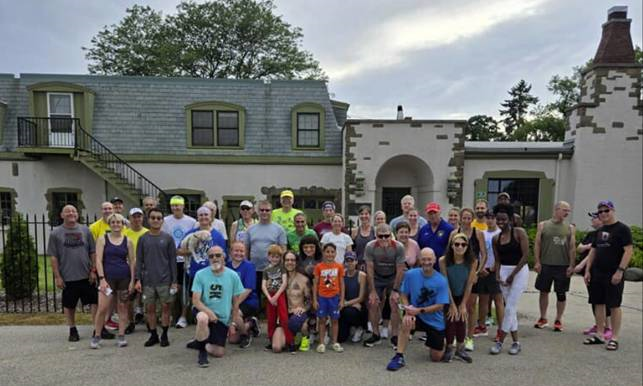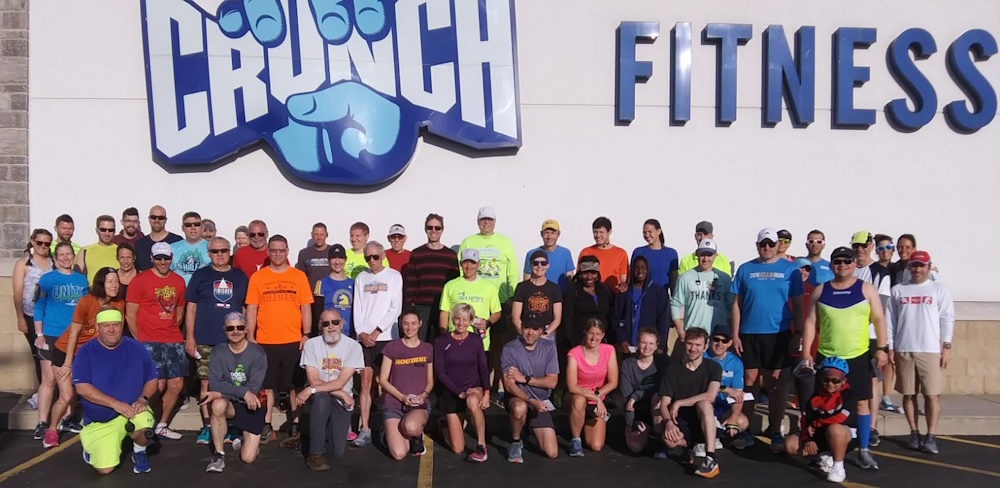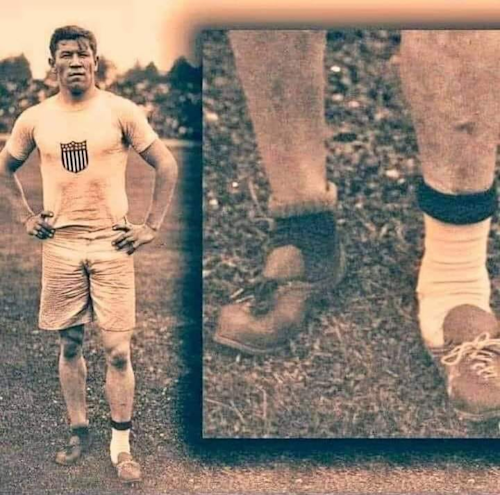July 2024
Fun Runs, Training Runs
Held the second Wednesday evening of the month during Spring, Summer and Fall.
- July 10, 2024, 6 pm - Our next Fun Run will start and finish at City Park, 500 E. Franklin St, Appleton. 3.7 or 6.2 mile course options along Fox River Newberry Trail. Spaghetti for all runners afterwards.
- August 14, 2024, 6 pm – Telulah Park, 1300 E Newberry St, Appleton.
- September 11, 2024, 6 pm – Riverside Park, 500 E Wisconsin Ave, Neenah.
- October 9, 2024, 6 pm - TBA

June 2024 Fun Run from Whiting Boathouse, Neenah.
Fox Cities Full/Half Marathon Summer Training Runs
Held every Saturday at 7 am until fall at Crunch Fitness, 2500 S Kensington Dr, Appleton.

Jim Thorpe Story – A Great Teaching Moment
This is Jim Thorpe. Look closely at the photo, you can see that he's wearing different socks and shoes.

This wasn't a fashion statement. It was the 1912 Olympics, and Jim, a Native American from Oklahoma represented the U.S. in track and field. On the morning of his competitions, his shoes were stolen. Luckily, Jim ended up finding two shoes in a garbage can. That's the pair that he's wearing in the photo. But they were not matching shoes, and one of them was too big, so he had to wear an extra sock. Wearing these shoes, Jim won two gold medals that day. This is a perfect reminder that you don't have to resign to the excuses that have held you back.
So what if life hasn't been fair? What are you going to do about it today? Whatever you woke up with this morning; stolen shoes, ill health, failed relationships, failed business, don't let it stop you from running your race. My friends, may we all strive to keep running in this life no matter what the problem with our shoes (or life) may be. Now be happy and go for gold as you "Live Life With No Regrets".
Outagamie County Bicycle and Pedestrian Plan – Project Update!
As you may be aware, Outagamie County is developing its first Bicycle and Pedestrian Plan to help expand and improve the county’s bicycle and pedestrian network, as was recommended in the County’s Comprehensive Plan and the County’s Comprehensive Outdoor Recreation Plan. Feedback was solicited on a proposed bicycle trail network (map) as well as guidelines for the designs of these routes. Here are the links to those documents, review the map draft HERE, and design guide HERE.
Have a question or concern? Contact Sadie DiNatale Burda, Principal Planner.

The Barkley Marathons
This event is certainly not for the faint of heart, its founder and host had some unusual ideas creating it. An award winning inspiring and entertaining documentary was created about it, you can watch it here Barkley Marathons Documentary
The Barkley course was the brain child of Gary "Lazarus Lake" Cantrell and Karl Henn (Raw Dog). The idea for the race was inspired upon hearing about the 1977 escape of James Earl Ray, the assassin of Martin Luther King Jr., from nearby Brushy Mountain State Penitentiary in Tennessee. Ray covered only about 12 miles after running 54 hours in the woods hiding from air searches during the day. Cantrell said to himself, "I could do at least 100 miles," mocking Ray's low mileage. Thus, the Barkley Marathons was born.
The course varies year to year in route, distance and elevation, but consists of 5 loops that each cover roughly 20 miles for a total of over 100 miles through challenging terrain in a Tennessee state park. The inaugural event was in 1986 and covered approximately 50 miles. Three years later the longer 100 mile course was introduced. A 60 hour cap was set for completion, and the first full course finisher did not happen until 1995 when Mike Williams of the UK finished with just 31 minutes to spare.

Each year the Barkley is limited to just 40 runners and usually fills up quickly the day registration opens. Requirements for submitting an entry application are a closely guarded secret with no details advertised publicly. Potential entrants must complete an essay on "Why I Should be Allowed to Run in the Barkley," pay a $1.60 application fee, and complete other requirements, subject to change. If accepted, an entrant receives a "letter of condolence." Upon arriving, first-time Barkley runners, known as virgins, are required to bring a license plate from their state/country as part of the entrance fee. Previous racers are required to bring an additional "fee" which in the past has included things such as a white shirt, socks, or a flannel shirt, as a donation for being a non-finisher. These donations are apparently based on the current needs of Lazarus Lake, the race organizer. Prior finishers of the marathon who return to run again must submit a pack of Camel cigarettes as part of the registration fee. Race bib number one is always given to the person deemed to be the least likely to finish one lap out of all who have applied; a "human sacrifice," as they like to call it.
The Barkley starts any time from midnight to noon on race day, with one hour till race start signaled by blowing a conch. The race officially begins when the race director lights a cigarette.
The course has no aid stations except for water jugs left at two points along the route. Some years have been so cold that these jugs became a frozen block of ice. Runners are allowed to study and copy the course map prior to the race, but once the race is underway they must navigate by their own notes alone. GPS devices are not allowed. The loop begins and ends at the yellow road gate where the runners' and supporters' parked cars stay. Runners of the 100-mile version take a counterclockwise direction for loops two and four, followed by each runner alternating direction on loop five, after the first-placed runner's choice. Depending on the start time of the first loop, either the second and fourth loops are run at night, or the first, third, and then fifth loops are run at night. Runners who complete three circuits of the loop (60-miles) are said to have completed a "fun run."
With 54,200 feet of accumulated vertical climb (and the same amount of descent), the 100-mile run is considered to be one of the most challenging ultramarathons held in the United States, if not the world. To date, more than half of the races ended with no finishers. The distance is nominal because it is measured horizontally; the actual length varies due to changes in the elevations on the course. Some say each loop is as long as 26 miles, yielding 130 miles for the full race and 78 miles for the "fun run."
In addition to running, competitors must find between 9 and 15 books along the course (the exact number varies each year) and remove the page corresponding to the runner's race bib number from each book as proof of course completion. Competitors are issued odd numbered race bibs and get a new race bib number, and thus a new page requirement, at the start of each lap.
The cut-off time for the 100-mile race is 60 hours overall, or an average of 12 hours per loop, and the cut-off for the 60-mile version of the race is 40 hours overall, which averages out to 13 hours and 20 minutes per loop. This also includes any rest/food time between loops. Once a competitor has started a loop (noted by the time they touch the famous yellow gate after collecting their next bib) they are not allowed to receive any assistance (other than from fellow runners) until they have finished that loop. When a runner drops out of the race, a bugler plays "Taps" upon their return to the start/end point. Out of more than 1,000 starts, the 100-mile race has been completed within the official 60-hour cut-off 26 times by 20 different runners, with one two-time finisher, one three-time finisher, and one four-time finisher. However, in 2006, nobody finished even the 60-mile "fun run" in under 60 hours.
In 2001, after several failed attempts, Blake Wood, 42, NM, and David Horton, 50, VA, finished together in 58:21, only to be disqualified for inadvertently leaving the course to follow a parallel route for about 200 yards. This route (on the south side of the stream instead of the north) had slightly better footing and had been the normal route until 2000. To give you some idea of the difficulty of this course, Wood had won the 2001 Rocky Raccoon 100 and the 1999 Hardrock 100 while Horton won the 1993 Hardrock and in 1991 set a course record for the Appalachian Trail, 2160 miles in 52 days.
In 2017, Gary Robbins of British Columbia reached the finishing gate a mere six seconds after the 60-hour cut-off, believing he had become the 16th runner ever to complete the Barkley. However, he had taken a wrong turn in the final stages of the race, thus cutting two miles off the course; he would have been disqualified even if he had been faster. "The time, in that situation, is meaningless," Cantrell said of the six-second time overage.
Until recently the best women's achievement was Sue Johnston's 66 miles (106 km) in 2001. In 2023, British runner Jasmin Paris surpassed that reaching the 9th book on the 4th lap before missing the cutoff time and having to drop out. Then this year Paris became the first female to ever complete the full course, reaching the finish with 99 seconds to spare from the 60 hour cutoff.
If any Pacesetter member is interesting in participating in the 2025 Barkley Marathons, we will cover your $1.60 registration fee and feature your agonizing experience in an upcoming newsletter.